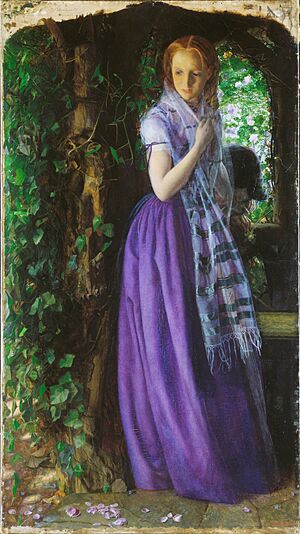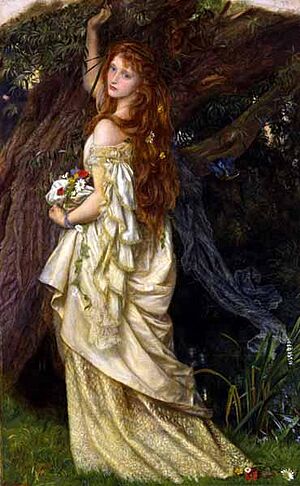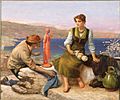Arthur Hughes (artist) facts for kids
Arthur Hughes (born January 27, 1832 – died December 22, 1915) was an English painter and illustrator. He was closely connected to a group of artists called the Pre-Raphaelite Brotherhood.
Biography of Arthur Hughes
Arthur Hughes was born in London. In 1846, he started studying art at Somerset House. His first teacher was Alfred Stevens. Later, he joined the Royal Academy schools.
While at the Royal Academy, he read a magazine called The Germ. This led him to meet famous artists like John Everett Millais, Holman Hunt, and Dante Gabriel Rossetti. Even though he never officially joined the Pre-Raphaelite group, he was a good friend and worked with them.
When he was just 17, his first painting, Musidora, was shown at the Royal Academy. After that, he showed his art almost every year. He exhibited his work at the Royal Academy and later at the Grosvenor and New Gallery. His painting Ophelia was shown near a similar painting by Millais. They became friends, and Hughes even posed for Millais' painting The Proscribed Royalist.
In 1855, Hughes married Tryphena Foord. She was the model for his painting April Love. They had five children. One of their children, Arthur Foord Hughes, also became a painter.
Arthur Hughes passed away in Kew Green, London, in 1915. He left behind about 700 paintings and drawings. He also created over 750 illustrations for books. After his wife Tryphena died in 1921, their daughter Emily had to move. Because of less space, she sadly had to destroy her father's sketches and all his personal letters. Hughes was the uncle of another artist, Edward Robert Hughes.
Arthur Hughes is buried in Richmond Cemetery.
Famous Artworks by Arthur Hughes
His most famous paintings are April Love and The Long Engagement. Both paintings show couples thinking about how love and beauty can change over time. These paintings were inspired by John Everett Millais's earlier works. However, Hughes focused more on the sadness of people struggling to keep young feelings alive, compared to nature's ability to renew itself. April Love was bought by William Morris.
Like Millais, Hughes also painted his own version of Ophelia. This painting is now at the Toledo Museum of Art. He also created illustrations for Keats's poem The Eve of St. Agnes. Hughes's version of this poem is a secular triptych. A triptych is a picture or carving on three panels. He used this same style for scenes from Shakespeare's play As You Like It. His artworks are known for their magical, glowing colors and very detailed drawing.
In 1855, his oil portrait Springtide was first shown in Dublin. It features his wife, Tryphena.
In 1857, Dante Gabriel Rossetti convinced Hughes to join a group of young artists. They went to Oxford to paint murals on the walls of the new debating hall at the Oxford Union Society. Rossetti chose the story of King Arthur as the theme for these wall paintings. Hughes was asked to paint a panel showing The Death of Arthur. Unfortunately, the walls were not prepared properly. Because of this, the paintings quickly faded. Today, only faint outlines of the artworks remain.
Book Illustrations
While some of Hughes' later paintings are not as well-known, his black and white drawings from that time are considered some of his best. He illustrated many books, including:
- Tom Brown’s Schooldays (1869)
- George Macdonald's At the Back of the North Wind (1871)
- The Princess and the Goblin (1872)
- Christina Rossetti’s Sing Song (1872)
- Speaking Likenesses (1874)
He also drew many pictures for Norman MacLeod's monthly magazine, Good Words.
See also
- List of Pre-Raphaelite paintings - includes catalogue of Arthur Hughes' work with links to individual paintings' articles.
- List of British painters









